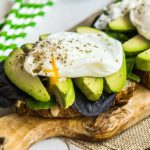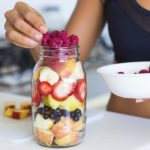
Tips for Feeding the Kids
Take the emotion out of mealtimes. Don’t argue or engage in negative comments the child may make about the meal. Try to focus on positive things.
Install a “two-bite rule”. They don’t have to eat it all but they do have to try just two bites. After that they can politely say “it’s not to my liking or no thank you”. Children have to try new food sometimes 40 times before they will willingly eat it without comment. So don’t give up and keep trying! Patience is key here. Remember, you are setting them up for a lifetime of good nutrition.
Offer choices. What goes into their mouths is often the only choice kids get to make about their daily life. They want to have some control over something and food is often where this need will show. By giving them choices about meals they can feel empowered. Of course, the choices you are offering are all healthy ones for the child.
Make sure they are hungry at mealtimes. Often picky eaters are the heaviest snackers. Remember that things like milk and juice can fill them up too.
Don’t put too much on the plate. Kids need less food than we imagine they do. It can seem overwhelming to them if there is too much there. If they finish things you can always offer more. Don’t force them to finish their plate. Some days they will be hungrier than others. They will not starve.
Set a good example. Kids won’t eat things if you don’t!
Always have vegetables available, for snacks and at mealtimes and include a salad. Most kids prefer veggies raw and dressing or dip makes everything taste better.
Engage the child in meal preparation. Take them to the grocery store and shop the healthy isles – the perimeter of the store, in most cases, is where all the fresh fruits, vegetables and meats are displayed. Let the child pick some of their favourite foods from these areas. At home ask them to help with the cooking. Most kids will at least try something they have had a hand in making and this leads to greater acceptance. Besides, you might just create the next best young chef!
Offer a variety of food at each meal and include at least one that you know the child likes. This way they feel less threatened by the other perhaps unfamiliar foods on the plate.
Don’t worry too much about balancing each meal. Kids can get the nutrition they need throughout the day.
Having said that, however… Breakfast is the most important meal! It sets the eating pattern for the day. If we start the day off with sugar or refined carbohydrates which raise blood sugar too quickly such as cereals, bread, bagels, pancakes etc. then we are setting them up for a repeating pattern throughout the day of blood sugar highs and lows, mood swings, frequent hunger and cravings for more refined carbs. This can affect not only moods but school performance, focus and attention.
So what to offer for breakfast? Protein.
Protein is essential for muscle building and growth as well as making important brain neurotransmitters.
Great breakfast ideas:
- Hardboiled eggs and fruit
- Scrambled or over-easy eggs and fruit
- Oatmeal with protein powder and fruit, include nuts
- Omelettes with fruit
- Sausages (natural ones) with fruit or veggies
- Leftovers from dinner – chicken fingers, pizza (yes, for breakfast!), meatballs, pasta with meat sauce
- Whole grain toast with almond butter or raw cacao nut butter
- Quiche
- Soup
- Apple or pear slices with nut butter
- Hummus and veggies or crackers
- High protein waffles or pancakes with fruit
- Protein-based breakfast bars
- Unsweetened yoghurt (Greek or goat) with fruit, mix in some stevia for sweetness
- Smoothies! With protein powder!
Avoid fizzy drinks, sports drinks and flavoured milk. Encourage kids to drink water. You can make this more flavourful by adding crushed berries or mint leaves. Make a herbal fruit iced tea and add stevia for sweetness. You can also cut unsweetened fruit juice with water.
When making dietary changes like going gluten or dairy-free (changes than can make a huge impact on many kids health) it is sometimes easier on all involved to do so slowly. Gluten and casein (the proteins in wheat and dairy) are involved in opiate-like addiction in the brain. This is why it is so difficult for people to give them up. This includes adults as well as kids! Consumption of these foods gives us a pleasure rush from brain chemicals and we, therefore, crave more of these foods in order to feel good. Taking the foods away cold turkey can lead to withdrawal symptoms such as fatigue, headaches and irritability or in your child’s case, just downright crankiness! It may be easier to gradually reduce the offending foods. Do this by slowly substituting one favourite food with another they have tried and accepted. For example, replace pasta with a brand of corn or brown rice pasta that they have accepted. Next week try different gluten-free pieces of bread. The following week replaces their cereal bar with homemade trail mix or a protein muffin. This approach works well for some families. Others may want to “just get it over with” and remove the foods all at once. This is fine too… just realize that any reactions are to be expected and are not simply your child being difficult☺
Be sneaky! You can add healthy foods into foods your child already likes and accepts. Your blender can be your best friend here☺ Puree fruits and vegetables and add them into soups, stews, baked goods such as pancakes and muffins, sauces, dips etc. Start with just a little at a time and slowly include more of the food. The child will gradually get used to the taste and eventually accept the food all on its own because it is not really unfamiliar anymore. Just don’t get caught or this can backfire on you!
Take snacks with you. This way you will be less tempted to stop at unhealthy options when kids get hungry.
Good portable snack options include:
- Nuts
- Trail mix
- Fresh fruit like apples, pears, cherries, bananas
- Protein muffins
- Homemade protein bars
- Homemade granola
- Dates stuffed with nut butters
If you are worried about what to send to nut-free schools, you can purchase a sunflower nut butter that tastes almost exactly like peanut butter and many kids love it.
Packing lunches can also be a challenge, as any parent of school-age children knows☺
We need to include protein, fibre and good fats to avoid the blood sugar rollercoaster and give kids every chance to succeed in school. Stay away from sugary drinks. Think about including lots of different kinds of foods rather than one big lunch – kind of a “bento box” approach. It also promotes more interest in the meal if you toss in at least one food your child really likes. Use a thermos to keep hot foods hot – not just soup but chicken fingers, meatballs, pasta…
Don’t worry too much if your child often eats the same things for lunch. You can provide variety at dinners.
Some great lunch ideas:
- Chicken fingers with dipping sauce
- Meatballs
- Pasta with meat sauce
- Soups
- Stews
- Raw veggies and dip
- Fruit salad
- Fruit and dipping sauce like yoghurt
- Slices of roast chicken or turkey
- Potato salad
- Hardboiled eggs/ scrambled eggs
- Sandwiches with protein or nut-free butter like sunflower
- Applesauce
- Hummus and corn chips
- Pizza (on gluten-free crust with goat cheese or Daiya if your child is sensitive)
- Smoothies
- Muffins
- Banana bread
- Fruit crumbles












